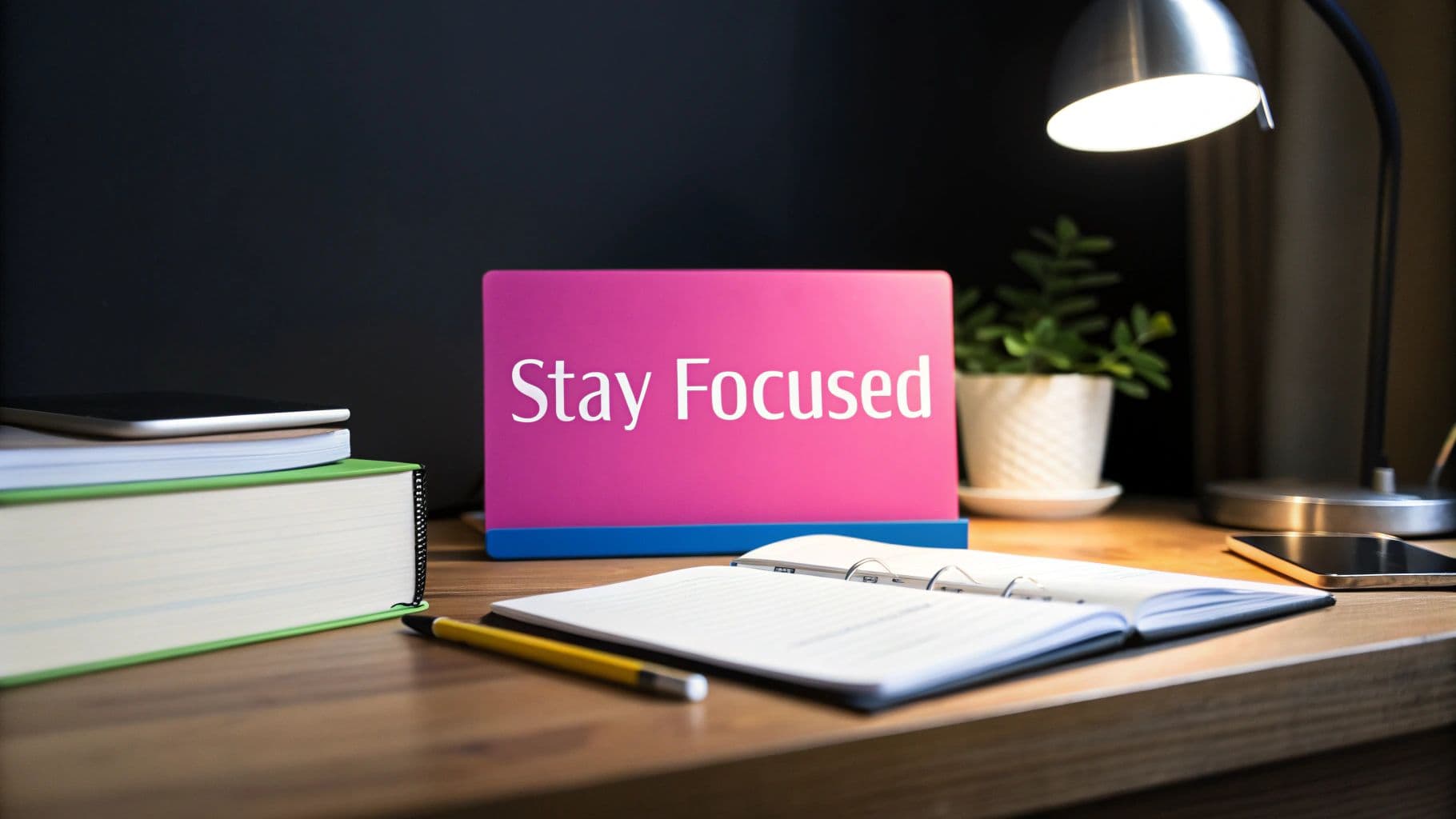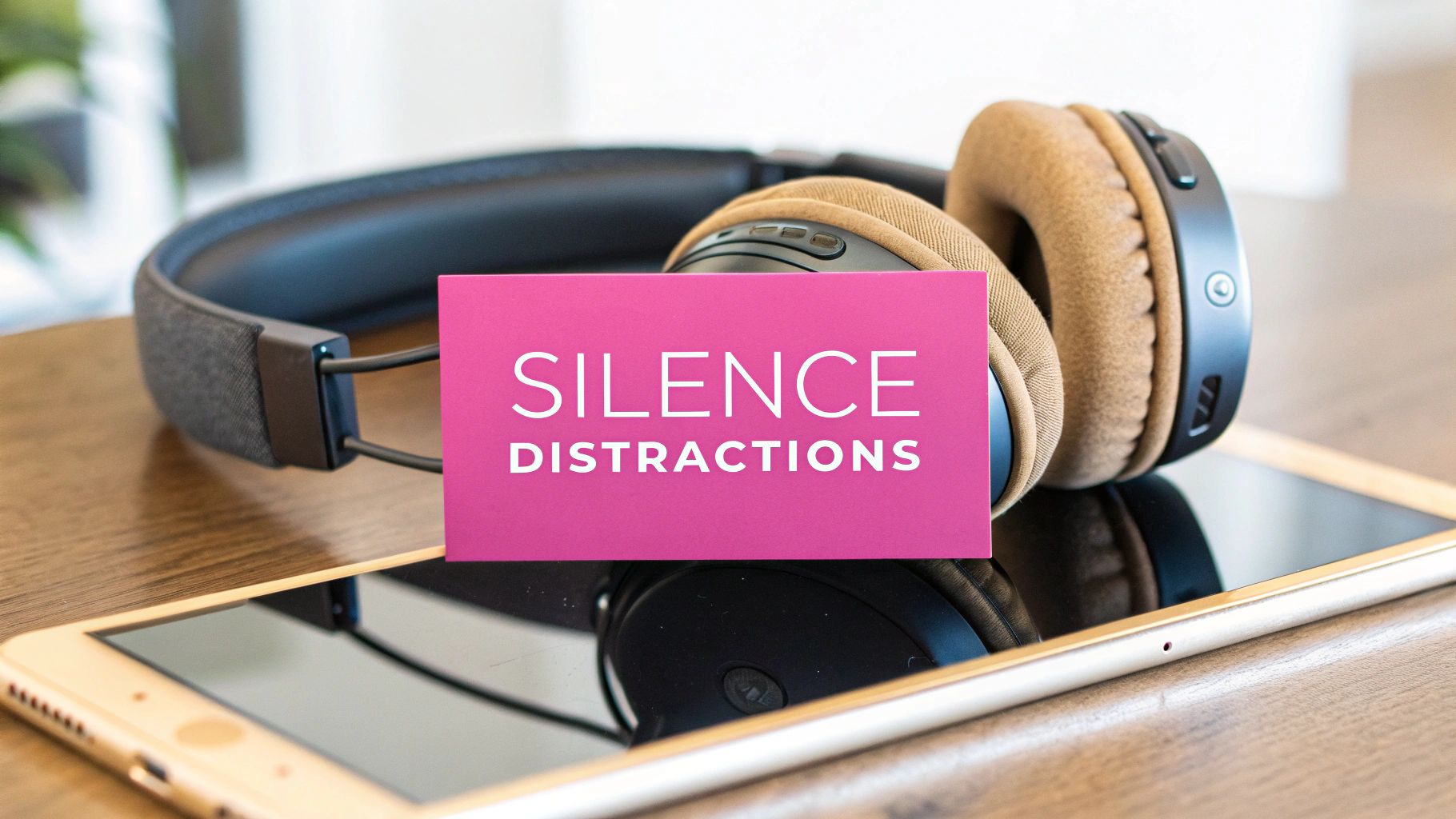
How to Stay Focused While Studying: Battle-Tested Methods That Actually Work
Navigating Modern Study Distractions

Finding focus while studying has become increasingly challenging in a world filled with endless alerts, messages, and social media updates. Each notification pulls at our attention, making it difficult to dive deep into learning material. Understanding exactly how these interruptions affect our concentration is essential for developing better study habits and reclaiming our ability to focus.
Understanding the Digital Distraction Deluge
Our phones and devices, while incredibly useful tools, often end up being the biggest barriers to focused study time. Most people check their devices dozens of times throughout the day, scattering their attention across multiple tasks. Consider trying to solve a complex calculus problem while messages pop up and social feeds refresh – this constant task-switching drains our mental energy and prevents us from reaching a state of deep concentration. The steady stream of information fragments our focus, making it progressively harder to engage with challenging academic work.
Implementing Effective Digital Boundaries
Setting clear limits on technology use during study sessions is one of the most powerful ways to protect your focus. This includes muting notifications, using apps that block distracting websites, and setting specific times to check messages and social media. Think of your study periods as protected time where digital interruptions are not allowed. A simple but effective strategy is to physically separate yourself from your devices – putting your phone in another room creates both a physical and mental barrier that helps maintain presence with your study materials.
Rewiring Study Habits for Deeper Focus
Beyond managing external distractions, developing stronger study habits is crucial for building sustained focus. This means shifting from passive approaches like re-reading notes to active learning methods such as practice tests and spaced repetition. For instance, after reading a chapter, try explaining the main concepts in your own words or create flashcards to test your understanding. Active engagement with the material forces your brain to process information more deeply, leading to better comprehension and retention.
Practical Strategies for Success
While the strategies above can significantly boost your focus, it's important to find methods that work for your individual learning style. Here are some proven approaches:
- Time Management Techniques: Test different methods like studying in 25-minute focused blocks with 5-minute breaks to discover what helps you maintain concentration without burning out. This structured approach helps sustain mental energy throughout study sessions.
- Mindfulness and Meditation: Regular mindfulness practice strengthens your ability to notice when your mind wanders and bring it back to the task at hand. Even 5-10 minutes of focused breathing daily can improve your attention span.
- Optimized Study Environment: Set up a dedicated workspace free from clutter and distractions. Whether it's finding a quiet corner, using noise-canceling headphones, or simply organizing your desk, a clean study space helps create the right mindset for focused work.
By understanding how modern distractions impact learning and implementing targeted strategies to manage them, you can create study conditions that support deep focus and effective learning. This focused approach to studying leads to better academic outcomes and builds valuable concentration skills for the long term.
Mastering Strategic Study Breaks

Successfully navigating long study sessions requires more than just willpower; it demands a strategic approach to breaks. Instead of viewing breaks as a guilty pleasure, consider them a vital part of effective learning. Understanding how to stay focused while studying involves recognizing when your brain needs a pause. This article explores the science behind effective breaks and how they can dramatically improve your study sessions.
The Science of Cognitive Recovery
Our brains aren't designed for continuous, intense focus. Think of your brain as a muscle: after extended use, it needs rest to recover and perform optimally. This means that our cognitive functions, such as attention and memory, become depleted during long periods of study. Research indicates that breaks, even short ones, can significantly refresh both brain and body, leading to increased energy and a renewed ability to focus. For instance, studies have shown that working in focused bursts with regular breaks can reduce mind wandering, a phenomenon that occurs roughly every 14 minutes during a typical task. As a result, strategically placed breaks can actually enhance your concentration and ability to absorb information.
Types of Breaks and Their Benefits
Not all breaks are created equal. While passively scrolling through social media might seem relaxing, it doesn't offer the kind of cognitive recovery your brain truly needs. Instead, consider these more effective break activities:
- Physical Activity: A short walk, some stretching, or even a quick burst of exercise can boost blood flow to the brain, thereby enhancing cognitive function. This could be as simple as a brisk walk around the block or a few stretches at your desk.
- Mindfulness and Meditation: Even just a few minutes of deep breathing or a guided meditation can calm the mind and improve focus. This provides a mental reset, clearing away distracting thoughts and preparing you for your next study session.
- Connecting with Nature: Stepping outside for some fresh air and sunlight can have a powerful restorative effect, reducing stress and improving mood. This kind of break offers a welcome change of scenery and can be particularly refreshing.
- Power Naps: A short power nap, lasting 15-20 minutes, can dramatically improve alertness and cognitive function without leaving you feeling groggy. Longer naps, however, can be counterproductive.
Timing Your Breaks for Maximum Impact
The timing of your breaks is just as important as the activities you choose. Many students find success with the Pomodoro Technique, which involves 25 minutes of focused study followed by a 5-minute break. After completing four of these cycles, a longer break of 15-30 minutes is recommended. However, the beauty of the Pomodoro Technique is its flexibility—you can adjust these intervals to better suit your individual needs and preferences. The key is to listen to your body and take a break before you feel completely exhausted. This proactive approach helps maintain mental stamina throughout your study session. Experiment to find the rhythm that best supports your ability to stay focused.
Practical Break Strategies
Integrating effective breaks into your study routine requires intentionality. Here are some practical strategies to help you make the most of your break time:
- Set a Timer: Use a timer to remind yourself to take breaks. This prevents you from becoming so engrossed in your studies that you forget to pause.
- Plan Your Break Activities: Decide beforehand how you will spend your break time to avoid defaulting to unproductive activities like endlessly scrolling through social media. This preparation ensures your breaks are truly restorative.
- Step Away from Your Study Space: Physically removing yourself from your study area helps create a mental separation between work and rest. This reinforces the purpose of the break and allows you to return to your studies feeling refreshed and ready to learn.
By mastering the art of strategic study breaks, you can transform your study sessions from exhausting marathons into productive sprints. Implementing these techniques empowers you to stay focused, maximizing your learning potential and reducing study-related stress.
Transforming Focus with The Pomodoro Method

Taking strategic breaks helps recharge our mental energy during long study sessions. This is exactly why the Pomodoro Technique has become such an effective study method. It's more than just setting a timer – it provides a practical framework for maintaining focus while tackling challenging subjects.
Understanding the Core Principles
At its heart, the Pomodoro Technique uses focused 25-minute work periods followed by 5-minute breaks. These work intervals are called "pomodoros," named after the tomato-shaped kitchen timer that Francesco Cirillo used when creating this method. After completing four pomodoros, you take a longer 15-30 minute break. Rather than forcing yourself to focus for hours straight, this approach works with your brain's natural attention cycles to help you stay fresh and avoid burnout.
Adapting the Pomodoro for Your Study Style
While 25 minutes is the standard interval length, the real strength of this technique is how easily you can adjust it. For instance, if you find yourself losing focus before the 25 minutes are up, try shortening your pomodoros to 20 minutes. Or if you're deeply engaged in your work and maintaining good concentration, extend them to 30 or 45 minutes. The key is to experiment until you find the timing that matches your personal study habits.
Handling Interruptions and Maintaining Momentum
Dealing with interruptions is one of the biggest challenges when trying to stay focused while studying. The Pomodoro Technique offers a straightforward approach: when something interrupts your work period, either handle it quickly if it takes less than two minutes or write it down to address during your next break. This helps you stay on track without losing your study momentum. Take a moment between each pomodoro to reflect on what you've accomplished and plan your next focus period. This simple practice helps track your progress and keeps you motivated.
Overcoming Common Pitfalls
Even though the Pomodoro Technique is remarkably simple, people often encounter some common challenges when using it. Many find themselves extending breaks longer than planned – setting a timer for break periods just like work periods can help prevent this. Others have trouble truly disconnecting during breaks, continuing to think about their studies. Remember that effective breaks involve activities that let your mind rest, like stretching or brief meditation, rather than checking email or social media which can scatter your attention. Keeping a log of your pomodoros can help you spot patterns and adjust your intervals for better results. By recognizing and addressing these typical obstacles, you can get the most benefit from the technique and significantly improve your study focus.
Harnessing Mindfulness for Deep Focus

We've explored how strategic breaks improve study sessions. Now let's look at how mindfulness can strengthen your ability to stay focused while studying. While techniques like the Pomodoro method provide structure, mindfulness helps train your mind to naturally resist distractions and stay present. The good news is that you don't need to meditate for hours – even brief mindful moments can significantly boost your concentration.
Understanding Mindfulness in a Study Context
At its core, mindfulness means paying attention to the present moment without judgment. When studying, this involves noticing when your thoughts wander and gently guiding your focus back to the material. For instance, if you catch yourself thinking about weekend plans during a study session, simply acknowledge that thought and return to your textbook without self-criticism. This mental training is especially valuable today, as research shows the average human attention span has shortened from 12 seconds in 2000 to just 8 seconds in 2020.
Practical Mindfulness Exercises for Students
Adding mindfulness to your study routine can be simple. Here are some effective exercises to try during study breaks or brief pauses:
- Focused Breathing: Take several deep breaths, paying attention to the physical sensations of breathing. This quickly calms your mind and sharpens focus.
- Body Scan: Move your attention through different parts of your body, observing any sensations without trying to change them. This anchors you in the present moment.
- Mindful Walking: During walking breaks, notice how your feet feel touching the ground, how your body moves, and what you see and hear around you. This combines physical movement with present-moment awareness.
Integrating Mindfulness into Your Study Routine
The key to seeing results is consistency. Just five minutes of daily mindful practice can noticeably improve your attention span. Try these ways to build mindfulness into your study schedule:
- Starting and Ending Study Sessions with Mindfulness: Begin and end each study period with brief mindful breathing to create mental clarity and focus.
- Using Mindfulness During Breaks: Instead of checking social media, use breaks for mindful activities like stretching or walking meditation.
- Practicing Mindful Note-Taking: Give full attention to the information as you write notes, focusing on main concepts and connections. This active engagement helps you learn and remember better.
Reaping the Rewards of Mindful Studying
Developing mindfulness skills does more than improve study focus – it's a valuable life skill. Regular mindful practice helps manage stress, regulate emotions, and support overall wellbeing. This builds resilience for handling academic challenges while creating a more positive learning experience. The goal isn't to eliminate all distractions but to respond to them more skillfully. Like physical exercise builds muscle, consistent mindfulness strengthens your ability to stay attentive and engaged with your studies. The result is more effective learning with less stress.
Creating Your Ultimate Study Environment
Your physical study space has a direct impact on your ability to focus and learn effectively. While mindfulness practices help train your mind, the environment where you study shapes how well you can maintain concentration. Just as a chef needs a well-organized kitchen to cook effectively, students need an optimized study space to learn efficiently. Let's explore how to create a study environment that helps you stay focused and productive.
The Power of Place: How Environment Influences Focus
Research shows that our surroundings significantly affect our ability to process and retain information. A messy desk can scatter your thoughts, while poor lighting or uncomfortable seating drains mental energy needed for studying. Setting up a dedicated study area, even a small corner, helps your brain recognize it's time to focus. This mental association makes it easier to transition into study mode. Studies show this is especially important since most people's attention spans naturally decrease when tired or stressed – with 90% admitting to losing focus during meetings. Your study space can either support or hinder your concentration.
Essential Elements of an Effective Study Space
These key factors help create an environment perfect for focused studying:
- Lighting: Natural sunlight works best, but bright, cool-toned lighting that resembles daylight is a good alternative. Good lighting helps regulate your body's natural rhythms and keeps you alert while studying.
- Temperature: Keep the room slightly cool rather than warm. When it's too warm, you're more likely to feel sleepy and unfocused. A cooler space helps maintain alertness.
- Noise Levels: Find a quiet spot or use noise-canceling headphones to block distractions. Some students concentrate better with soft background sounds like white noise or instrumental music – test different options to see what helps you focus best.
- Organization: Keep your desk tidy and materials well-organized so you can find what you need quickly. A clean space creates a sense of calm that makes it easier to concentrate.
- Comfort: Get a good chair that supports proper posture. Being physically uncomfortable makes it hard to focus for long periods, so investing in ergonomic furniture is worth it for productive study sessions.
Tailoring Your Environment to Your Needs
While these guidelines work for most people, the perfect study environment varies from person to person. Some students need complete silence, while others focus better with ambient noise. Some thrive with everything perfectly organized, while others work well with controlled chaos. Try studying in different places – libraries, coffee shops, various rooms at home – to discover your ideal setting. Add personal touches that motivate you, whether that's plants, artwork, or inspiring quotes. The goal is creating a space where you naturally feel focused and ready to learn.
Maintaining Your Ideal Study Space
Once you've set up your optimal study environment, maintain it consistently. Regularly clear clutter from your desk, keep materials organized, and check that lighting and temperature stay at good levels. This routine reinforces the connection between your space and productive studying, making it easier to concentrate each time you sit down to work. Just as athletes need the right training conditions to perform their best, your study environment plays a key role in helping you learn effectively and reach your academic goals.
Building Sustainable Study Habits That Last
Creating effective study habits isn't just about short-term focus – it's about developing reliable practices that support your academic success over time. Rather than relying on quick fixes, you need a personalized approach that works with your natural patterns and helps maintain concentration, especially during challenging periods.
Identifying Your Peak Performance Times
Everyone has optimal times of day when their mind is sharpest and most receptive to learning. Take time to notice when you feel most alert and engaged – are your best study sessions early in the morning or do you think more clearly in the evening? By testing different schedules, you can pinpoint your peak focus hours and plan your most demanding work accordingly. This self-knowledge helps you study more efficiently and avoid wasting energy at suboptimal times.
Managing Energy Levels for Optimal Focus
Your ability to concentrate directly depends on your physical and mental energy. Think of your focus as a limited resource that gets used up throughout the day, particularly when you're tired or under pressure. To maintain steady concentration while studying, make sure you're meeting basic needs like adequate sleep, good nutrition, and hydration. Research shows that even mild dehydration can hurt your ability to think clearly and retain information. Taking care of these fundamentals creates a strong base for sustained focus.
Creating a Personalized Study Routine
Study methods that work well for one person may be completely ineffective for another. The key is finding an approach that matches your peak times, energy patterns, and learning style. This could mean working in short, focused intervals with frequent breaks, or dedicating longer blocks to deep concentration on complex topics. Try different techniques like the Pomodoro method, scheduling dedicated study periods, and building in regular review sessions. Having a clear routine reduces decision fatigue and makes it easier to stay on task.
Tracking Progress and Adjusting Strategies
Building lasting study habits requires ongoing evaluation and refinement. Keep notes about your study sessions – which times of day work best? Which techniques help you learn most effectively? This data helps you optimize your methods for better results. For instance, if you notice your focus dropping in the afternoons, try taking a brief walk or doing some quick exercises to boost your energy before returning to work. Being flexible and willing to adjust your approach leads to better long-term outcomes.
Maintaining Motivation Through Challenging Periods
Even with solid study habits, motivation can dip during difficult academic stretches. Stay focused by setting realistic goals, celebrating progress, and reconnecting with your core reasons for studying. Build a support network of friends, family, or study groups who can provide encouragement when things get tough. These connections help maintain perspective and determination through challenging times. Remember that sustainable study habits aren't about perfect focus – they're about creating reliable systems that support steady progress despite obstacles.
Transform your study habits and boost your academic performance with Notescast. Turn your notes and study materials into engaging videos that make learning more efficient and enjoyable. Check it out today at https://notescast.app/.
